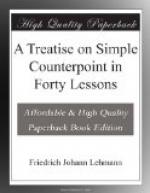[Illustration: Fig. 64.]
The fifth may be used in the lower part if it becomes the preparation of a suspension (Fig. 65_a_). It may also be used in the lower part, as in Fig. 65_b_, provided it resolves by skipping to the third of the chord.
In skipping from the fifth to the root, or the reverse, in the lower part, do so in an upward direction. The fifth, when treated as an harmonic passing-tone, may, however, be approached either ascending or descending.
[Illustration: Fig. 65.]
The retardation should be used only when prepared by the leading-tone. It rises a semitone in resolving. [Fig. 66.]
[Illustration: Fig. 66.]
The following dissonant intervals may be used on the first half of the measure:—When the counterpoint is above, the fourth and seventh in suspension, and second and fifth in retardation; and when below, the second in suspension, and the fourth and seventh in retardation. [Fig. 67.]
[Illustration: Fig. 67.]
Consecutive fifths on consecutive strong beats of the measure are good when one of the tones of the second fifth is prepared, as in Fig. 68.
[Illustration: Fig. 68.]
The following cadences are good:
[Illustration: Fig. 69.]
EXERCISES
Write one eight-measure phrase with two notes to the measure in one part and six in the other; one with three notes in one and six in the other; and one with two notes in one part and four in the other. (Fig. 59.) In combining the species in this and succeeding lessons the student may place any species in any part.
To the cantus firmus write two counterpoints above and two below, in the fourth species.
CANTUS FIRMUS
[Illustration: Fig. 70.]
LESSON VII
FOURTH SPECIES (Continued)
The first and fourth species may be mixed as in Fig. 71. Rules for writing other than the first species in both parts are to be regarded.
[Illustration: Fig. 71.]
EXERCISES
To cantus firmus a write two counterpoints above and two below, in the fourth species.
To cantus firmus b write two above and two below, three half-notes to the measure, with syncopations.
Write two eight-measure phrases, mixing the first and fourth species.
CANTI FIRMI
[Illustration: Fig. 72.]
LESSON VIII
COMBINING THE FOURTH SPECIES WITH THE OTHERS
All previous rules for combining species still apply.
In combining the fourth species with other than the first, the following intervals may be used on the first half of the measure, in addition to those mentioned in Lesson VI: When the counterpoint is below, the fourth, fifth and seventh in suspension, and the ninth in retardation; and when above, the fifth in suspension, and the seventh in retardation; but in every such case the part having other than the fourth species must skip to some other chord-tone before resolving the suspension. [Fig. 73.]




